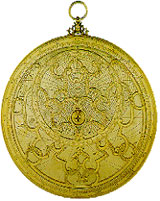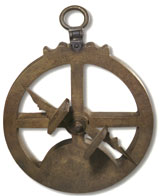 |
|
|
|
Nicol Patenal’s planispheric astrolabe 1616 (front) on display in the Museu da Marinha, Lisbon
|
|
 |
|
|
|
Nautical astrolabe made by the Portuguese on display in the Museu de Marinha in Lisbon
|
|
|
|
The astrolabe is the development of an idea from ancient Greece, brought to us via the Arabs. The oldest ones to have been discovered were built in the tenth century. Throughout the world, there are approximately 1500 ancient astrolabes of various types, including nautical ones. The astrolabe that existed at the beginning of the period of the Discoveries is the so-called planispheric astrolabe, a very complex and delicate instrument designed not only to measure the altitude of the stars and planets and to calculate the time according to the position of the sun, but also to foresee the position of the stars and planets on a specific day of the year at a specific time. The piece has a main circular body, called mater, where a disk is placed with a projection of the celestial sphere on the equatorial plane and with several disks for the various latitudes. The so-called pointer rotated on this ring, pointing with small, artistically designed spikes to the position of the biggest stars.
There is a large variety of planispheric astrolabes, the reverse of which normally contains a sighting device or alidade, known as a diametrical rule, which is pointed at the heavenly bodies in order to measure their altitude. The reverse also contains engravings used to calculate the time based on the height of the sun or to measure the height of a building.
The planispheric astrolabe was a very sophisticated instrument, an authentic analogical computer that required great accuracy and complex calculations for its construction. It is thought that such instruments were never constructed in our country, however the simplified astrolabe which the cosmographers and navigators of the Discoveries are said to have invented became an instrument of great utility for navigation. It is believed that this nautical astrolabe appeared in the fifteenth century, yet the oldest instrument of which there is knowledge dates back to 1540.
The nautical astrolabe is made up simply of a graduated arc, with an axis in the centre, held by a crosspiece and a sighting device or alidade, the so-called diametrical rule, which rotates on this axis. This instrument is heavier and more robust than the planispheric astrolabe. It does not offer great resistance to the wind and remains easily in an upright position, even under the difficult conditions of deep-sea navigation.
The nautical astrolabe was used to measure the altitude of the heavenly bodies, namely that of the North Star or of the sun at noon. To this effect, the diametrical rule had two small plates, the pinnules, with holes in the centre, through which the observer looked at the stars, or through which the rays of the sun shone, to align the sighting device with the direction of the heavenly body.
By measuring the angular altitude of the North Star, it is possible to calculate the latitude of a place. In the North Celestial Pole, the North Star appears on the zenith, vertically above the observer – its altitude corresponds to the latitude of 90 degrees north. At the equator, the North Star appears on the horizon – its altitude corresponds to latitude zero of the place. All of these are approximate measurements, as the North Star was not, and is still not, exactly in the North Celestial Pole. In order to measure the latitude using the North Star, it was necessary to compensate the altitudes using a set of rules that made up the so-called North Star Rule.
As navigators approached the equator, and even more so when they travelled to the southern hemisphere where the North Star can no longer be seen, measuring the latitude by this star became impossible. South of the Equator there is no star that can be seen so easily and that can serve as the North Star in the south. Instead, the Rule of the Southern Cross was used, based on the Alpha star of this constellation. However, this method was not used very much as this star is very far away from the Pole. It was thus decided to use the rule of the sun at noon, whereby the latitude was calculated by the altitude of the meridian of this heavenly body, i.e. its maximum daily height, comparing it with the declination of the sun, which was known for each day of the year by the almanac, the first of which was drawn up by Abraham Zacut.
The nautical astrolabes used to measure the altitude of the sun differed from those used to measure the altitude of the stars. The holes in the sighting devices were smaller and instead of looking through them, the pilots used to hang the astrolabe at waist height and turn the diametrical rule until the light of the sun passed through the two holes and projected onto the floor or other surface. The altitude of the sun was then measured using the graduated circular disk. This process was given the suggestive name of “weighing the sun”. It was by weighing the sun with nautical astrolabes that the Portuguese mariners ploughed the Atlantic, Indian and Pacific oceans.
Nuno Crato